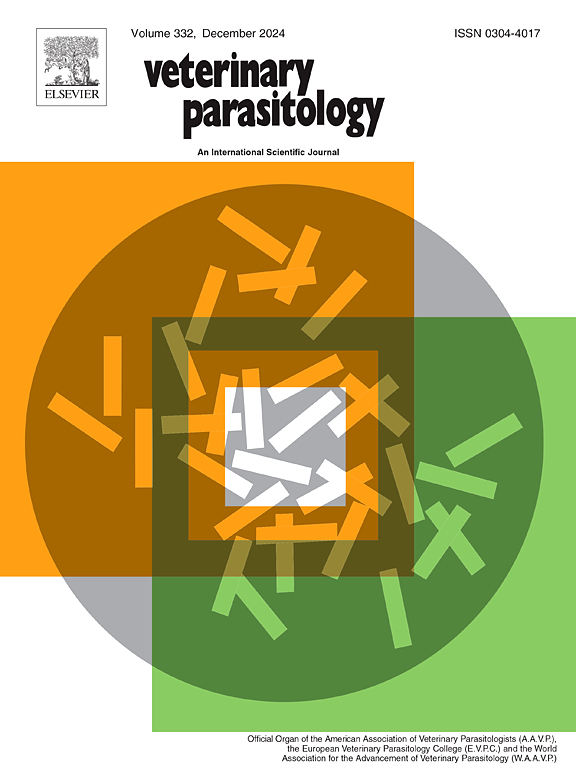自然感染犬新孢子虫的小牛多巴胺能神经病理学
IF 2.2
2区 农林科学
Q2 PARASITOLOGY
引用次数: 0
摘要
犬新孢子虫是一种导致牛流产和先天性神经系统疾病的原生动物寄生虫。虽然它对生殖的影响已经确定,但与先天性感染相关的神经化学改变仍不清楚。本研究旨在评估自然感染的新生小牛脑内犬新冠病毒抗原分布与多巴胺能标记物表达的空间关系。对感染小牛和健康小牛的脑组织进行组织病理学和免疫组织化学检查。免疫组化采用抗犬链球菌、酪氨酸羟化酶(TH)、多巴胺受体D1 (DRD1)和多巴胺转运蛋白(DAT)的抗体。局部免疫反应性进行半定量评价和组间比较。仅在感染小牛中观察到抗原阳性,主要在神经元细胞质中,并在前脑和大脑皮层中最为突出。TH在这些区域的表达明显增加,而DRD1和DAT的表达中度降低或区域改变。除1例外,无组织囊肿。这些发现表明,区域特异性多巴胺能失衡与寄生定位有关。这种模式与先前描述的弓形虫模型的变化相似,表明犬弓形虫也可能损害发育中的大脑中的多巴胺能调节。需要进一步的行为和分子研究来探索先天性新孢子病的神经化学后果。本文章由计算机程序翻译,如有差异,请以英文原文为准。
Dopaminergic neuropathology in calves naturally infected with Neospora caninum
Neospora caninum is a protozoan parasite that causes abortion and congenital neurological disorders in cattle. Although its reproductive effects are well established, the neurochemical alterations associated with congenital infections remain unclear. This study aimed to evaluate the spatial relationship between N. caninum antigen distribution and the expression of dopaminergic markers in the brains of naturally infected neonatal calves. Brain tissues from infected and healthy calves were examined histopathologically and immunohistochemically. Immunohistochemistry was performed using antibodies against N. caninum, tyrosine hydroxylase (TH), dopamine receptor D1 (DRD1), and dopamine transporter (DAT). Regional immunoreactivity was semi-quantitatively assessed and compared between groups. Antigen positivity was observed only in infected calves, mainly within neuronal cytoplasm, and was most prominent in the forebrain and cerebral cortex. TH expression was markedly increased in these regions, while DRD1 and DAT expression was moderately reduced or regionally altered. Tissue cysts were absent except in one case. These findings indicate a region-specific dopaminergic imbalance associated with parasitic localization. This pattern is similar to previously described changes in Toxoplasma gondii models and suggests that N. caninum may also impair dopaminergic regulation in the developing brain. Further behavioral and molecular studies are warranted to explore the neurochemical consequences of congenital neosporosis.
求助全文
通过发布文献求助,成功后即可免费获取论文全文。
去求助
来源期刊

Veterinary parasitology
农林科学-寄生虫学
CiteScore
5.30
自引率
7.70%
发文量
126
审稿时长
36 days
期刊介绍:
The journal Veterinary Parasitology has an open access mirror journal,Veterinary Parasitology: X, sharing the same aims and scope, editorial team, submission system and rigorous peer review.
This journal is concerned with those aspects of helminthology, protozoology and entomology which are of interest to animal health investigators, veterinary practitioners and others with a special interest in parasitology. Papers of the highest quality dealing with all aspects of disease prevention, pathology, treatment, epidemiology, and control of parasites in all domesticated animals, fall within the scope of the journal. Papers of geographically limited (local) interest which are not of interest to an international audience will not be accepted. Authors who submit papers based on local data will need to indicate why their paper is relevant to a broader readership.
Parasitological studies on laboratory animals fall within the scope of the journal only if they provide a reasonably close model of a disease of domestic animals. Additionally the journal will consider papers relating to wildlife species where they may act as disease reservoirs to domestic animals, or as a zoonotic reservoir. Case studies considered to be unique or of specific interest to the journal, will also be considered on occasions at the Editors'' discretion. Papers dealing exclusively with the taxonomy of parasites do not fall within the scope of the journal.
 求助内容:
求助内容: 应助结果提醒方式:
应助结果提醒方式:


